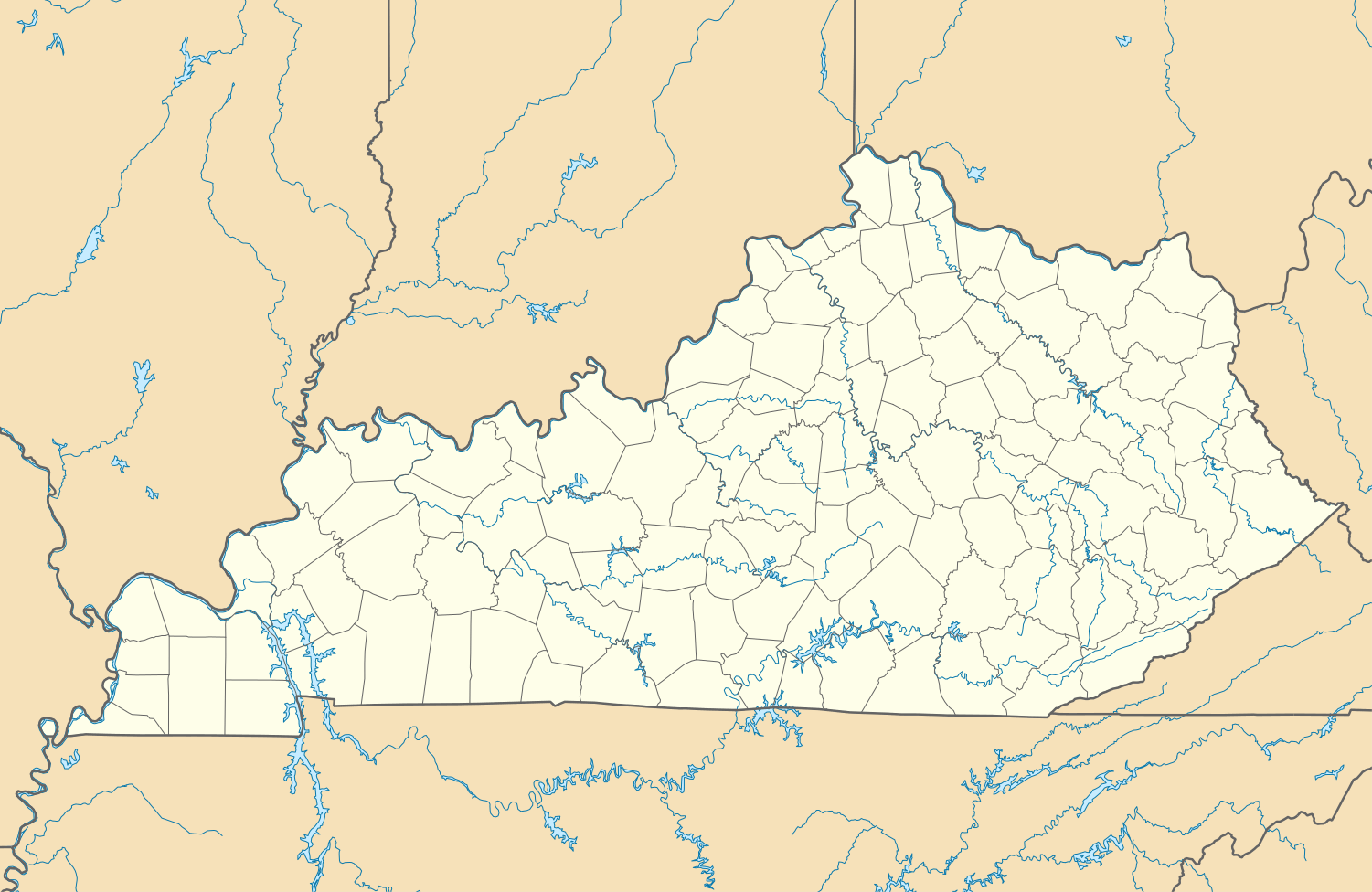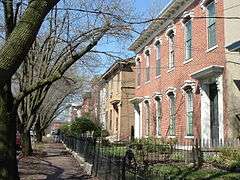Butchertown, Louisville
Coordinates: 38°15′26.96″N 85°43′41.53″W / 38.2574889°N 85.7282028°W
|
Butchertown Historic District | |
|
Washington Street in Butchertown | |
  | |
| Location | Roughly bounded by Main, Hancock, Geiger, Quincy Sts., US 42, South Fork of Beargrass Creek, and Baxter Ave., Louisville, Kentucky |
|---|---|
| Area | 50 acres (20 ha) |
| Built | 1873 |
| Architect | Adolph Druiding; D.X. Murphy and Company |
| Architectural style | Greek Revival, Shingle Style, Other, shot-gun |
| NRHP Reference # | 76000900[1] |
| Added to NRHP | August 11, 1976 |
Butchertown is a neighborhood just east of downtown Louisville, Kentucky, USA, bounded by I-65, Main Street, I-71, Beargrass Creek and Mellwood Avenue.
History
The first homes in the area were laid out in the 1820s along the newly completed Louisville to Lexington turnpike, referred to in that stretch as Story Avenue. Two of the first landowners in the area, Whig Party loyalist George Buchanan and Isaac Stewart, had the new community's streets named after major Whig Party members, such as John Quincy Adams, Daniel Webster and Henry Clay. In the 1850s Beargrass Creek was rerouted away from what is now downtown Louisville and through the area, making it an ideal area for butchers and stockyards because the animal remains could be dumped in the creek and such businesses were banned in the downtown area for sanitation reasons. The population swelled as waves of German immigrants entered the area. Bourbon Stockyards, built in 1836, was the first stockyard to locate in Butchertown — currently, parts of the original building house a bank.
Due to the high German population, and resentment of them by supporters of the Know Nothing party, Butchertown was where the "Bloody Monday" riots of August 1855 began as Know Nothings tried to prevent Germans and Irish from voting in an election. The riots killed 22 people.
For the first 100 years of its existence, Butchertown was a thriving residential and industrial area, though other Louisville neighborhoods regarded it as a haven for drunkards and brawlers. However, the area began declining after the great Ohio River flood of 1937 destroyed many of the homes there. Many other homes were demolished for the construction of the Ohio River flood wall, the construction of interstates and the Kennedy Interchange ("Spaghetti Junction") through the area, and the expansion of industrial land into formerly residential areas. Suburbanization continued to bring the residential areas into decline, until the few remaining residents began lobbying for rezoning (the entire area was zoned as industrial), and fixing up vacant and underrepaired houses.
Since the 1990s the area has attracted many young professionals. In recent years, the east Market Street area of downtown Louisville has seen a great deal of revitalization, including the expansion of Waterfront Park, Louisville Slugger Field, and the conversion of empty store fronts into new condominiums. This has helped spur further improvements in Butchertown itself, as many new antique shops and art galleries have opened off the Market Street corridor. Currently, a large condominium complex is planned near the Heigold House, and the former Big Four railroad bridge in the adjacent waterfront park has been converted into the longest pedestrian-only bridge in the world.
In the 2000s, there were plans as part of the Ohio River Bridges Project to move the Kennedy Interchange further south when it was to be reconfigured by 2018, meaning that more buildings in Butchertown would be razed. However, these plans were scrapped in favor of reconfiguring the interchange in its existing location. Furthermore, the project included a second interstate bridge just east of the John F. Kennedy Memorial Bridge that opened as the Abraham Lincoln Bridge on December 6, 2015. The necessity of flyover ramps for the new bridge led to the demolishing of about one-third of Butchertown's David Armstrong Extreme Park, along with a rebuild of facilities on an adjacent property.[2]
Demographics
As of 2000, the population of Butchertown was 975,[3] of which Whites were 82.8%, Blacks were 7.2%, Hispanics were 5.3%, and other races were 4.7%. Males of all races were 60.1% of the population, while females were 39.9%.
Attractions
Butchertown contains several attractions, including the David Armstrong Extreme Park and Thomas Edison House, a shotgun house near where Thomas Edison lived in 1866 on Washington Street. The remaining front facade of the former early 19th century Heigold House, which features a detailed sketch of important early Whig Party leaders, displays the words "dedicated the greatest man in history, George Washington" etched across its front. The rest of the Fulton Street house has been razed.
See also
- Germantown, Louisville
- History of the Germans in Louisville
- National Register of Historic Places listings in Jefferson County, Kentucky
References
- ↑ National Park Service (2010-07-09). "National Register Information System". National Register of Historic Places. National Park Service.
- ↑ Shafer, Sheldon (2014-01-01). "Louisville Extreme Park rebuild getting under way". The Courier-Journal. Louisville, Kentucky. Retrieved February 17, 2016.
- ↑ "Community Resource Network". Retrieved 2005-11-18.
External links
- Street map of Butchertown
- Images of Butchertown (Louisville, Ky.) in the University of Louisville Libraries Digital Collections
- "Butchertown: When Meat Packers Set Up Shop, It Spawned a Host of Livelihoods for German Immigrants" — Article by Bill Pike of The Courier-Journal
 |
Ohio River |  | ||
| Downtown Louisville | |
Clifton Heights | ||
| ||||
| | ||||
| Phoenix Hill, Irish Hill | Clifton |

